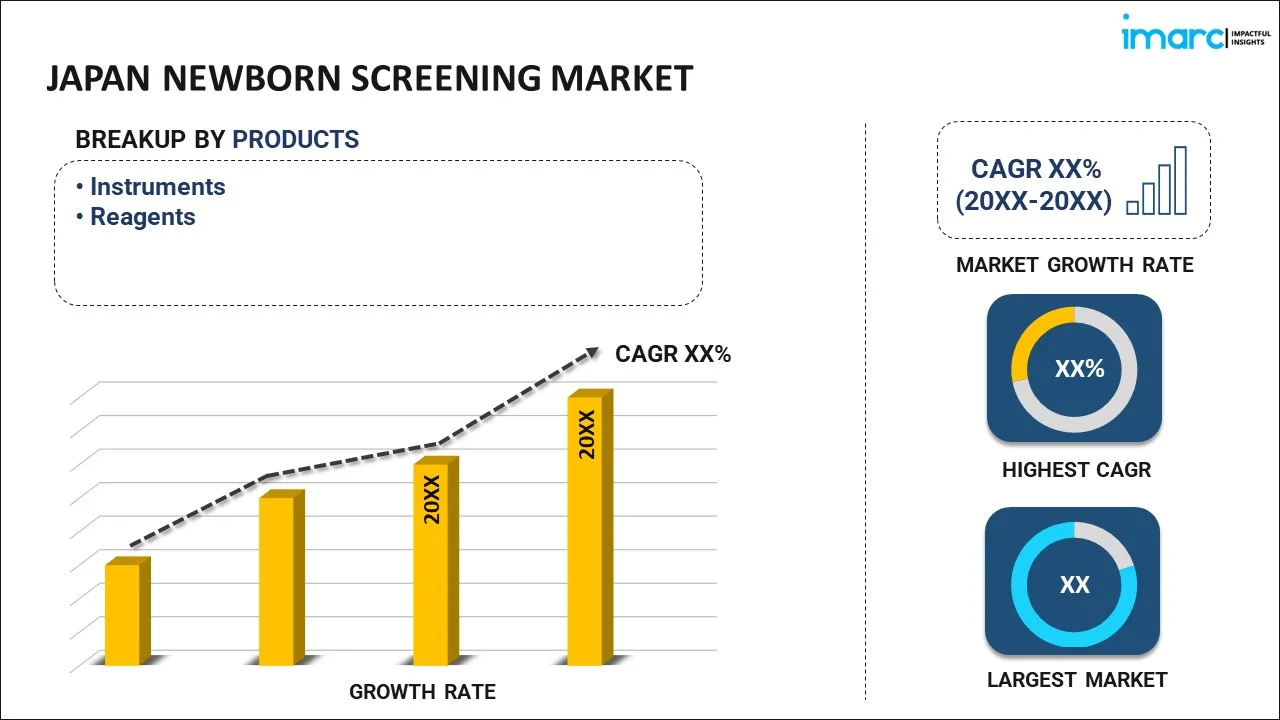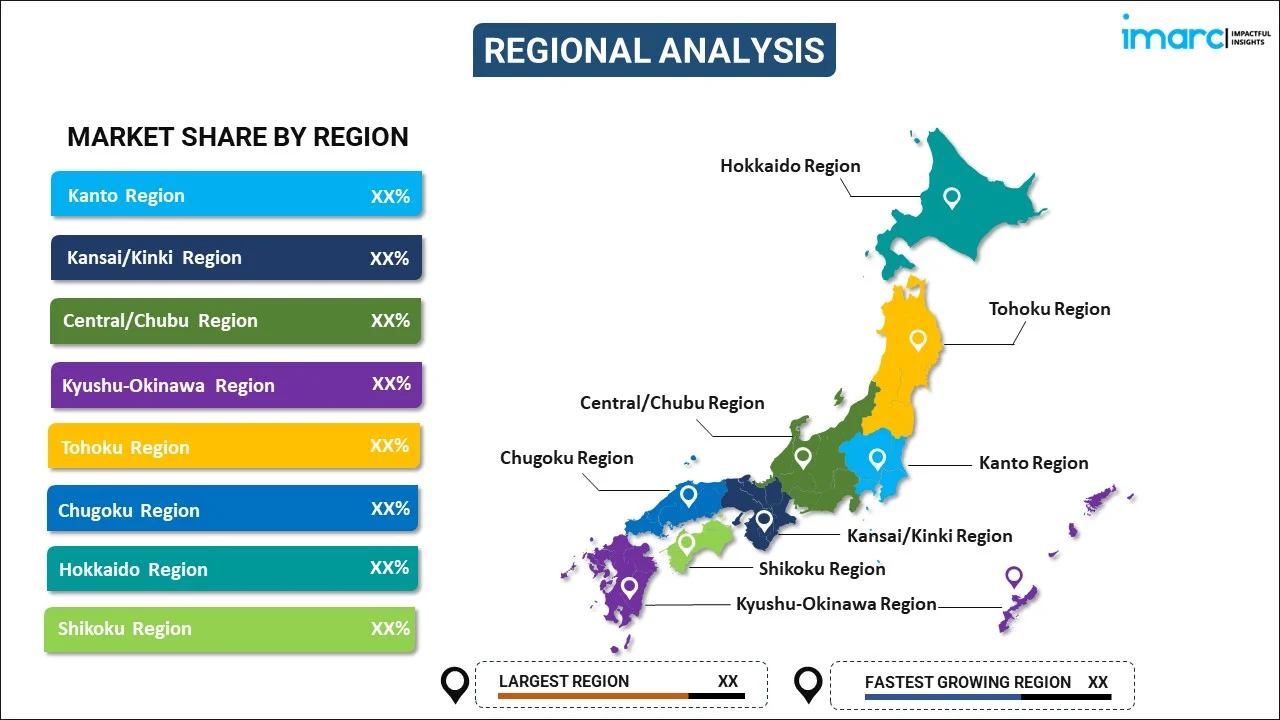
Japan Newborn Screening Market Report by Product (Instruments, Reagents), Technology (Tandem Mass Spectrometry, Pulse Oximetry, Enzyme Based Assay, DNA Assay, Electrophoresis, and Others), Test Type (Dry Blood Spot Test, CCHD, Hearing Screen), and Region 2025-2033
Market Overview:
Japan newborn screening market size reached USD 64.4 Million in 2024. Looking forward, IMARC Group expects the market to reach USD 107.5 Million by 2033, exhibiting a growth rate (CAGR) of 5.9% during 2025-2033. Continuous innovations in medical technology for more accurate outcomes and efficiency of disease detection are primarily driving the regional market.
|
Report Attribute
|
Key Statistics
|
|---|---|
|
Base Year
|
2024 |
|
Forecast Years
|
2025-2033
|
|
Historical Years
|
2019-2024
|
| Market Size in 2024 | USD 64.4 Million |
| Market Forecast in 2033 | USD 107.5 Million |
| Market Growth Rate (2025-2033) | 5.9% |
Newborn screening encompasses a series of laboratory assessments and point-of-care examinations designed for the early detection, diagnosis, and intervention of genetic, metabolic, hematological, or hormonal disorders that may not manifest immediately after birth. The primary objective is to identify diseases that have the potential to cause significant morbidity, mortality, and intellectual disability (ID) at an early stage, enabling prompt initiation of treatment before symptoms become evident. The typical newborn screening process involves the collection of a small blood sample from the baby's heel, which is subjected to a straightforward blood test. Subsequently, the blood sample undergoes testing to assess various conditions, including metabolic disorders, endocrine irregularities, and blood-related ailments such as phenylketonuria (PKU), cystic fibrosis, and sickle cell anemia. Should the initial screening results suggest a genetic disorder in the newborn, additional confirmatory testing becomes necessary to validate the diagnosis. This enables timely administration of appropriate treatment and the establishment of a follow-up care plan for the infant's well-being.
Japan Newborn Screening Market Trends:
The Japan newborn screening market is witnessing significant growth, primarily driven by heightened parental concerns for their children's health, especially among new parents. This concern is rooted in the increasing prevalence of congenital conditions in infants. Parents are becoming more aware of the critical role early detection and diagnosis play in facilitating timely medical intervention and treatment, further propelling the market's expansion. Advancements in medical technology and genetic testing have significantly broadened the range of disorders that can be screened for, enhancing the market's prospects. Governments and healthcare organizations are increasingly adopting newborn screening programs, adding to the market's positive trajectory. Ongoing product innovations, such as the integration of next-generation sequencing and tandem mass spectrometry, offer improved screening accuracy and speed, further bolstering market growth. The availability of direct-to-consumer genetic testing and a growing focus on personalized medicine are driving tailored treatments tailored to individuals' specific genetic profiles, further stimulating market demand. Factors such as increased healthcare expenditure, rapid digitization, higher internet speeds, the emergence of online health communities, and extensive research and development (R&D) efforts will contribute to the market's overall growth and advancement over the forecasted period.
Japan Newborn Screening Market Segmentation:
IMARC Group provides an analysis of the key trends in each segment of the market, along with forecasts at the country level for 2025-2033. Our report has categorized the market based on product, technology, and test type.
Product Insights:

- Instruments
- Reagents
The report has provided a detailed breakup and analysis of the market based on the product. This includes instruments and reagents.
Technology Insights:
- Tandem Mass Spectrometry
- Pulse Oximetry
- Enzyme Based Assay
- DNA Assay
- Electrophoresis
- Others
A detailed breakup and analysis of the market based on the technology have also been provided in the report. This includes tandem mass spectrometry, pulse oximetry, enzyme based assay, DNA assay, electrophoresis, and others.
Test Type Insights:
- Dry Blood Spot Test
- CCHD
- Hearing Screen
The report has provided a detailed breakup and analysis of the market based on the test type. This includes dry blood spot test, CCHD, and hearing screen.
Regional Insights:

- Kanto Region
- Kansai/Kinki Region
- Central/ Chubu Region
- Kyushu-Okinawa Region
- Tohoku Region
- Chugoku Region
- Hokkaido Region
- Shikoku Region
The report has also provided a comprehensive analysis of all the major regional markets, which include Kanto Region, Kansai/Kinki Region, Central/ Chubu Region, Kyushu-Okinawa Region, Tohoku Region, Chugoku Region, Hokkaido Region, and Shikoku Region.
Competitive Landscape:
The market research report has also provided a comprehensive analysis of the competitive landscape. Competitive analysis such as market structure, key player positioning, top winning strategies, competitive dashboard, and company evaluation quadrant has been covered in the report. Also, detailed profiles of all major companies have been provided.
Japan Newborn Screening Market Report Coverage:
| Report Features | Details |
|---|---|
| Base Year of the Analysis | 2024 |
| Historical Period | 2019-2024 |
| Forecast Period | 2025-2033 |
| Units | Million USD |
| Scope of the Report | Exploration of Historical and Forecast Trends, Industry Catalysts and Challenges, Segment-Wise Historical and Predictive Market Assessment:
|
| Products Covered | Instruments, Reagents |
| Technologies Covered | Tandem Mass Spectrometry, Pulse Oximetry, Enzyme Based Assay, DNA Assay, Electrophoresis, Others |
| Test Types Covered | Dry Blood Spot Test, CCHD, Hearing Screen |
| Regions Covered | Kanto Region, Kansai/Kinki Region, Central/ Chubu Region, Kyushu-Okinawa Region, Tohoku Region, Chugoku Region, Hokkaido Region, Shikoku Region |
| Customization Scope | 10% Free Customization |
| Post-Sale Analyst Support | 10-12 Weeks |
| Delivery Format | PDF and Excel through Email (We can also provide the editable version of the report in PPT/Word format on special request) |
Key Questions Answered in This Report:
- How has the Japan newborn screening market performed so far and how will it perform in the coming years?
- What has been the impact of COVID-19 on the Japan newborn screening market?
- What is the breakup of the Japan newborn screening market on the basis of product?
- What is the breakup of the Japan newborn screening market on the basis of technology?
- What is the breakup of the Japan newborn screening market on the basis of test type?
- What are the various stages in the value chain of the Japan newborn screening market?
- What are the key driving factors and challenges in the Japan newborn screening?
- What is the structure of the Japan newborn screening market and who are the key players?
- What is the degree of competition in the Japan newborn screening market?
Key Benefits for Stakeholders:
- IMARC’s industry report offers a comprehensive quantitative analysis of various market segments, historical and current market trends, market forecasts, and dynamics of the Japan newborn screening market from 2019-2033.
- The research report provides the latest information on the market drivers, challenges, and opportunities in the Japan newborn screening market.
- Porter's five forces analysis assist stakeholders in assessing the impact of new entrants, competitive rivalry, supplier power, buyer power, and the threat of substitution. It helps stakeholders to analyze the level of competition within the Japan newborn screening industry and its attractiveness.
- Competitive landscape allows stakeholders to understand their competitive environment and provides an insight into the current positions of key players in the market.
Need more help?
- Speak to our experienced analysts for insights on the current market scenarios.
- Include additional segments and countries to customize the report as per your requirement.
- Gain an unparalleled competitive advantage in your domain by understanding how to utilize the report and positively impacting your operations and revenue.
- For further assistance, please connect with our analysts.
 Inquire Before Buying
Inquire Before Buying
 Speak to an Analyst
Speak to an Analyst
 Request Brochure
Request Brochure
 Request Customization
Request Customization




.webp)




.webp)












